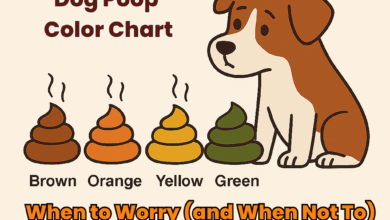When Counting Squirrels Fails: Melatonin & Other Natural Fixes For Dogs Who Pace, Panic, And Refuse To Sleep
When you purchase through links on our site, we may earn a commission. Here’s how it works.
If your dog turns neurotic during thunderstorms, panics when you grab your keys, or insists on nocturnal pacing—melatonin might be worth your attention.
Table of Contents
Most pet parents reach for it in hopes of calming anxiety, but its role doesn’t stop there. This little hormone also interacts with sleep regulation, oxidative stress, cognitive aging, and, oddly enough, fur.
Before you toss a chewable at the problem, here’s what you should actually know.
What Is Melatonin, Really?
Melatonin is a hormone with humble beginnings and wide-reaching influence. Though best known for its role in sleep, it also interacts with systems involved in stress, aging, immunity, and behavior.
A Peek Inside The Pineal Gland
Tucked between the two hemispheres of the brain lies the pineal gland—a tiny, pinecone-shaped organ with an outsized role in regulating sleep. It responds to changes in light and dark, converting serotonin into melatonin as daylight fades.
In both dogs and humans, it functions like a biological nightlight switch, signaling the body to wind down and prepare for rest.

What’s elegant about this system is how responsive it is to environmental cues. What’s problematic is how easily those cues can be distorted—by artificial lighting, inconsistent routines, or underlying stress.
How Melatonin Works In Dogs vs Humans
Melatonin production increases with darkness and decreases with light—a pattern that helps anchor circadian rhythm. But in dogs affected by chronic anxiety, cognitive aging, or environmental overstimulation, that rhythm can fall out of sync, leading to nighttime restlessness, pacing, or difficulty settling.
While the fundamental mechanism is shared across species, dogs may be more sensitive to environmental disruption and more dependent on consistency. Unlike humans, they don’t override routine with screens or stimulants—they unravel when the rhythm breaks.
Supplemental melatonin may help restore that natural rhythm. It doesn’t sedate—it cues the body toward rest. In addition to its effects on sleep, melatonin is being studied for a range of other potential benefits in dogs, including:
- Reduction of oxidative stress through its antioxidant properties
- Neuroprotection in age-related cognitive dysfunction
- Support for dogs with Cushing’s disease by influencing cortisol regulation
- Hair regrowth in cases of seasonal or idiopathic alopecia
In short, melatonin plays a larger role than many assume. While it’s best known for its connection to sleep, it may also support broader physiological resilience—especially when used with intention and proper guidance.
Is Melatonin Safe For Dogs?
For most healthy adult dogs, melatonin is considered safe when used appropriately and under veterinary guidance. It’s not classified as a drug but as a dietary supplement, which means it’s not regulated as strictly—and not all formulations are created equal. That’s where things can get tricky.
What Science (And Vets) Say
Although melatonin isn’t FDA-approved for veterinary use, it’s frequently recommended in clinical settings, especially for dogs with situational anxiety, sleep disturbances, or age-related behavioral changes.
Studies in canine models suggest melatonin is well tolerated, with a low risk of serious side effects at appropriate doses. It’s also non-habit forming and doesn’t act like a sedative—it works by nudging the body’s natural sleep-wake rhythm back into sync.
However, product quality matters. Many over-the-counter melatonin supplements are formulated for humans and may include xylitol (a common sweetener that’s toxic to dogs) or added botanicals that aren’t tested in veterinary contexts. That’s why it’s critical to use vet-approved or pet-formulated melatonin only.
Breed-Specific Considerations
There’s no definitive list of breeds that should or shouldn’t take melatonin, but individual sensitivity may vary. Brachycephalic (flat-faced) breeds may already have compromised sleep due to airway issues—so melatonin won’t fix the root cause and could dull responsiveness if dosed too high.

Additionally, breeds prone to Cushing’s disease (like Dachshunds, Boxers, and Beagles) may be more likely to encounter melatonin as part of an adjunct treatment plan. In these cases, monitoring cortisol levels and timing the dose is especially important.
If your dog has a complex medical history or breed-specific vulnerability, your vet may recommend bloodwork before introducing melatonin.
Can Puppies or Senior Dogs Take It?
Melatonin isn’t commonly used in young dogs unless there’s a specific medical or behavioral reason. Their sleep-wake cycles and brain chemistry are still developing, and calming interventions are best addressed through routine, structure, and gentle behavior training.
Older dogs with cognitive dysfunction syndrome or disrupted sleep cycles may benefit the most from melatonin. In these cases, the goal isn’t sedation—it’s improved rhythm, reduced nighttime anxiety, and better quality of life.
Studies suggest melatonin may offer neuroprotective benefits in aging brains, helping ease sundowning symptoms and nighttime restlessness.
Why Vets Use Melatonin: More Than Just Sleep
Although melatonin is best known for its role in sleep regulation, veterinarians increasingly use it for a range of behavioral and physiological conditions—many of which have little to do with bedtime.
It’s not a sedative. It’s a signal-modulating hormone with wide-reaching effects on mood, inflammation, endocrine balance, and neural function. Here’s where it shows the most promise:
Anxiety & Situational Stress
Thunderstorms, fireworks, travel, vet visits, separation—dogs live in a world they can’t control. For many, that lack of control becomes chronic anxiety.
Melatonin can help take the edge off in high-stress situations. By supporting GABAergic activity, it may reduce the intensity of fear-based reactions without knocking a dog out.

It’s often paired with behavioral modification, supplements like L-theanine, or pharmaceuticals when needed.
Canine Insomnia & Sleep Disorders
Some dogs simply can’t settle. Whether due to restlessness, shifting circadian rhythms, or nighttime anxiety, melatonin may help reinforce the sleep-wake cycle and make nighttime less chaotic.
This is especially valuable in older dogs or those with irregular routines, travel disruptions, or shelter transitions.
Hair Loss (Alopecia X and Seasonal Shedding)
In cases of Alopecia X—a poorly understood, non-inflammatory hair loss condition—melatonin has shown success in stimulating hair regrowth, particularly in Nordic breeds like Pomeranians and Huskies.
It’s also sometimes used in dogs with seasonal flank alopecia, though results vary. Its exact mechanism here isn’t fully understood, but it likely relates to melatonin’s influence on reproductive hormone signaling and cellular antioxidant defense.
Cognitive Decline In Senior Dogs
As dogs age, they may develop signs of cognitive dysfunction, the canine counterpart to dementia. Symptoms include nighttime pacing, disorientation, vocalization, and disrupted sleep.

Melatonin has been explored as a neuroprotective agent, helping regulate sleep and potentially slowing the progression of cognitive decline. It may also reduce nighttime anxiety and improve sleep architecture in older dogs.
Cushing’s Disease (Hyperadrenocorticism)
Some vets use melatonin as part of a supportive plan for dogs with Cushing’s disease, especially in atypical or early-stage cases. Melatonin may help regulate adrenal hormone production and balance excess cortisol, though it’s not a replacement for medical treatment.
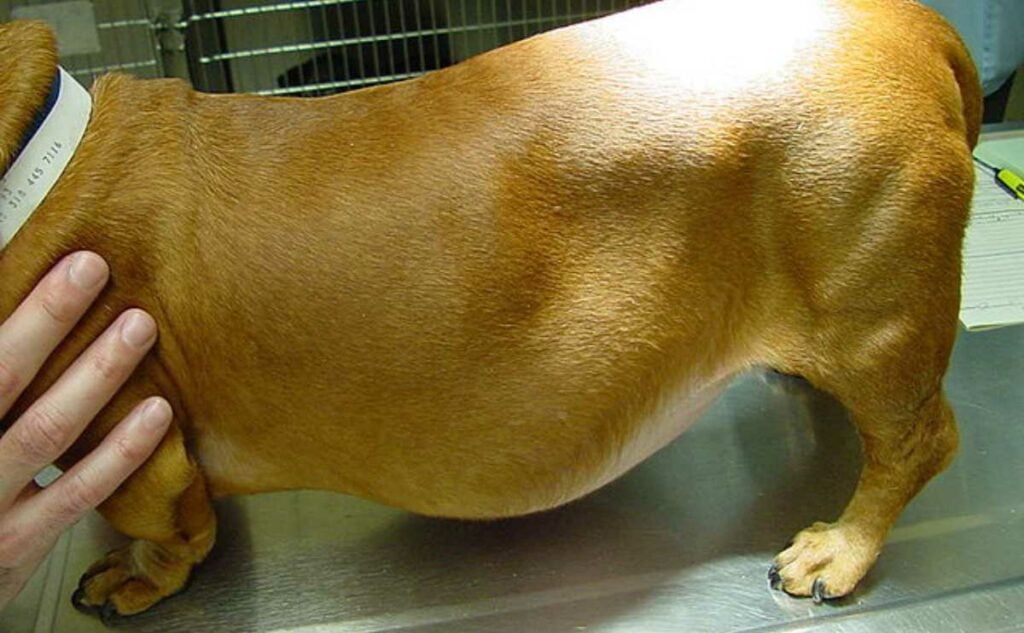
Often paired with lignans or other natural compounds, it’s used in dogs who don’t tolerate conventional therapies—or whose owners want a more conservative approach.
Radiation Exposure & Oxidative Stress
Melatonin is a powerful antioxidant, able to cross the blood-brain barrier and directly scavenge free radicals. In veterinary oncology and research models, it’s been studied as a potential adjunct therapy to mitigate oxidative stress from radiation or illness.
Cancer Support (Adjunct Care)
Though not curative, melatonin is sometimes used alongside cancer treatment to support immune health, minimize inflammation, and counteract the side effects of chemotherapy or radiation.
Its antioxidant properties, coupled with possible anti-angiogenic effects (limiting blood supply to tumors), have prompted interest in melatonin as a low-risk, integrative therapy—especially in palliative care.
Side Effects, Interactions & Red Flags
Melatonin is widely considered safe for dogs, but “natural” doesn’t mean risk-free. Like any supplement, its effects can vary depending on the dog, the dose, and what else is going on inside that body.
Here’s what to expect—and what to watch for.
Mild Side Effects (Usually Short-Lived)
- Digestive upset: mild nausea, gas, or soft stools
- Drowsiness or lethargy (most common; often expected)
- Changes in appetite or mood (rare, but reported in some cases)
- Increased sleepiness the next morning (if dosage is too high or timing is off)
Most of these resolve within a day or two and don’t require intervention unless they persist or worsen. If your dog seems more sedated than soothed, it’s time to revisit the dosage—or stop altogether.
Interactions: What Not To Combine
Melatonin may interact with other medications, particularly those that influence the nervous, endocrine, or immune systems.
Use caution if your dog is also on:
- Sedatives or anti-anxiety medications (e.g., trazodone, gabapentin, benzodiazepines)
- Corticosteroids (melatonin may interfere with cortisol feedback loops)
- Thyroid medications (melatonin may suppress thyroid hormone levels in some cases)
- Insulin or diabetes medications (may affect glucose metabolism)
If your dog takes any long-term medications, it’s essential to talk with your vet before introducing melatonin—even if the supplement is marketed as “safe” or “all natural.”
What The Science Says About Long-Term Use
There’s limited long-term research on melatonin in dogs, but what we do know is promising. Studies suggest it’s non-habit forming, doesn’t accumulate in the body, and generally maintains its effect over time.
That said, most veterinarians recommend using melatonin as-needed or in cycles, rather than continuously. This helps avoid tolerance, gives the body a chance to recalibrate, and makes it easier to monitor for subtle side effects.
For dogs with cognitive dysfunction or chronic anxiety, longer-term use may be appropriate—but it should be re-evaluated every few months as part of a broader treatment plan.
Melatonin Dosage Chart For Dogs
How much melatonin can you give a dog? That depends on your dog’s weight, health status, and the reason you’re using it.
Anxiety? Hair loss? Sleep disruption? Each case may call for a slightly different approach—which is why it’s always best to consult your veterinarian first.
That said, there are general dosage ranges commonly recommended by vets.
Typical Melatonin Dosage By Weight
| Dog Weight | Typical Dose (up to 3x daily) |
|---|---|
| Under 10 lbs | 1 mg |
| 10–25 lbs | 1.5 mg |
| 26–100 lbs | 3 mg |
| Over 100 lbs | 3–6 mg |
These doses are often given every 8 to 12 hours depending on the use case and how the dog responds.
For sleep issues, a single dose in the evening may suffice. For hair loss or Cushing’s, your vet might suggest more frequent, consistent dosing.
Timing: When To Give Melatonin
Now that we know how much melatonin is safe for dogs, the next question is: When should I give melatonin to my dog?
For most dogs, melatonin is most effective when given 1 to 2 hours before the desired effect. If you’re using it to encourage sleep or reduce nighttime anxiety, plan to give it before evening restlessness sets in.
If you’re using it for daytime stress (e.g., car rides or vet visits), morning or midday dosing may be appropriate.
Delivery Options: What To Look For
Melatonin supplements for dogs come in a variety of forms, and choosing the right one can make all the difference in safety, absorption, and effectiveness:
- Chewables: Easy to administer; often flavored, but check for added sweeteners
- Tablets or capsules: Typically more precise; ideal for dogs who take pills easily
- Liquid drops: Good for small dogs or picky eaters; easy to dose, but shelf stability varies
- Slow-release formulations: May help maintain melatonin levels over a longer period, especially for overnight use
Avoid human melatonin products unless approved by your vet—many contain xylitol or other additives that are toxic to dogs.
Our Personal Experience With Melatonin For Dogs
We have used the K9 Select Melatonin to help manage our two-year old dog’s anxiety and related behaviors. He eats it up like it’s a treat, so it’s very easy to administer. On days when we give it to him, he is much calmer and barks less, making all of us more relaxed.
– Michelle Schenker, Canine Journal
What Makes A Good Melatonin Supplement For Dogs?
Not all melatonin supplements are created equal—especially when you’re shopping in a market filled with human formulations, misleading labels, and inconsistent quality standards.
Choosing the right product can make the difference between calming support and an emergency vet visit.
Here’s what to watch for:
Hidden Ingredients That Can Be Toxic
Many melatonin supplements marketed for humans contain inactive ingredients that are unsafe for dogs, the most dangerous being:
- Xylitol – a sugar substitute that’s highly toxic to dogs, even in small amounts
- Added herbs – can be too sedating or interfere with other medications
- Artificial sweeteners, dyes, or flavorings – not necessarily toxic, but often irritating or unnecessary
Bottom line: Never give your dog a human melatonin supplement unless your vet has reviewed the label.
Melatonin-Only vs Synergistic Formulas
Some products contain pure melatonin only. Others include synergistic compounds include:
- L-theanine – an amino acid known for reducing anxiety without sedation
- Chamomile or passionflower – gentle botanicals that support relaxation
- Vitamin B6 or magnesium – involved in melatonin synthesis and nervous system function
For some dogs, a melatonin-only product may be the safest and most predictable starting point.
For others—especially those with chronic stress or sleep cycle disruption—a multi-ingredient formula may offer broader support.
Just be sure to evaluate every ingredient for safety, dosage, and potential interactions with your dog’s existing medications or conditions.
Certifications That Actually Matter
Since supplements aren’t regulated as tightly as pharmaceuticals, third-party testing is your best ally. Look for products that carry certifications from:
- NASC (National Animal Supplement Council) – indicates compliance with quality standards for animal health products
- NSF International – certifies manufacturing practices and ingredient integrity
- Third-party lab testing – confirms the supplement contains what it claims, and nothing it shouldn’t
If a product doesn’t clearly state its sourcing, testing, or certifications, consider that a red flag—not just a missing detail.
Top-Rated Melatonin Products For Dogs
When it comes to melatonin for dogs, quality control isn’t optional—it’s essential. The best supplements are precisely dosed, free of toxic additives, and formulated with veterinary insight.
Below are three top-rated options that strike a balance between safety, effectiveness, and ease of use—each suited to different needs.
Pet Wellbeing Pet Melatonin For Dogs
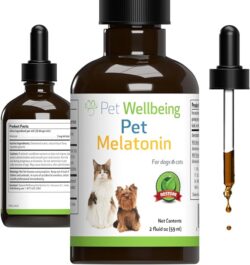
- Form: Liquid (2 oz bottle)
- Ingredients: Melatonin, deionized water, natural bacon flavor, vegetable glycerin
- Best For: Small dogs, picky eaters, and dogs needing precise dose adjustments
- Why It Stands Out: Liquid form allows micro-dosing for extra-small breeds or tapering. Free of artificial additives and easy to mix with food.
K9 Select Melatonin Chewable Tablets
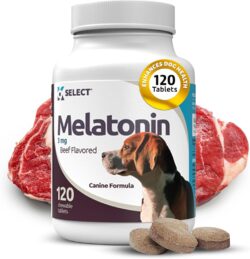
- Form: Beef-flavored chewable
- Ingredients: Melatonin, dicalcium phosphate, liver, roast beef flavor, magnesium stearate, stearic acid, silicon dioxide
- Best For: Dogs with situational anxiety or mild insomnia
- Why It Stands Out: Low-dose format makes it ideal for first-time use or small breeds. No herbal blends—just melatonin and dog-friendly flavor.
Note: Contains magnesium stearate and silicon dioxide, which are safe in small quantities but may not suit dogs with very sensitive digestion.
NaturVet Quiet Moments Calming Aid + Melatonin
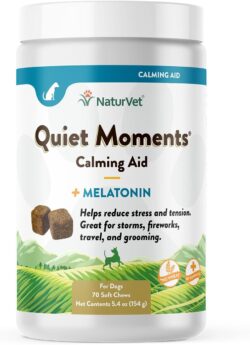
- Form: Soft chew (70 count)
- Active Ingredients: Melatonin, chamomile, passion flower, L-tryptophan, thiamine, ginger
- Best For: Dogs with chronic stress, separation anxiety, or sleep cycle disruption
- Why It Stands Out: Combines melatonin with calming botanicals and amino acids for a multi-pathway approach. Great for dogs who need broad-spectrum relaxation.
Ideal as a “bedtime treat” ritual—just be sure to monitor for interactions if your dog is on meds.
Alternatives To Melatonin For Dogs
While melatonin is a popular go-to for dogs with anxiety, sleep issues, or cognitive decline, it’s not the only tool in the natural medicine cabinet. Depending on your dog’s needs—whether you’re managing situational stress, chronic inflammation, immune decline, or even cancer support—other therapies may offer better alignment.
The right alternative depends on the “why.” Is your dog pacing at night? Struggling with aging? Recovering from illness? Here’s how herbal, nutritional, and functional alternatives may fit your dog’s specific challenges.
Herbal Alternatives For Calm, Sleep & Recovery
- Valerian root: A deeply relaxing sedative herb that acts on the central nervous system. Useful for dogs with high reactivity or panic behaviors. Best for short-term use or acute stress (storms, fireworks).
- Passionflower: Used for acute situational anxiety, such as travel, vet visits, or crate rest. Acts as a natural sedative with minimal cognitive dulling.
- Catnip: Not just for cats—catnip is a sedative and nervine in dogs. Gentle and short-acting, it may calm the nervous system without reducing awareness.
- Hop: Yes, the same plant used in brewing beer. Hops contain natural sedative compounds and may help dogs who are restless or struggle to stay asleep.
- Lemon balm: Eases digestive discomfort and nervous tension. Particularly helpful for dogs who internalize stress in their gut—think loose stools or appetite changes during anxiety.
- Skullcap: A gentle nervine ideal for chronic anxiety or long-term use. Helps reduce excitability without the fog of sedation. Often paired with valerian or passionflower.
- Chamomile: Mildly anti-inflammatory and calming, chamomile supports both digestion and emotional regulation. Often used in multi-ingredient calming blends.
- Oat Straw: Rich in minerals and nourishing to the nervous system, especially in elderly dogs or those recovering from burnout or overstimulation.
- Ashwagandha: An adaptogen known for helping the body regulate stress hormones like cortisol. Often used in calming blends, it’s particularly helpful for dogs with chronic anxiety and reactivity.
Medicinal Mushrooms For Aging & Immune Support
- Lion’s Mane: Known for its potential to stimulate nerve growth factor (NGF), Lion’s Mane is increasingly studied for neuroprotection and memory support. In dogs, it may help slow cognitive decline, support brain regeneration, and even improve focus or orientation in cases of Canine Cognitive Dysfunction.
- Reishi: Sometimes called the “queen” of medicinal mushrooms, reishi supports emotional balance, immune resilience, and nervous system stability. It’s often used for dogs with chronic anxiety, immune issues, or inflammatory conditions.
- Shiitake: Rich in antioxidants and beta-glucans, shiitake may help protect brain cells and reduce oxidative stress—particularly useful in senior dogs or those with cognitive dysfunction.
- Turkey Tail: One of the most studied mushrooms in veterinary oncology, turkey tail is rich in polysaccharide-K (PSK)—a compound shown to stimulate immune cells and possibly slow tumor progression.
Other Calming & Neuroprotective Supplements for Dogs
- GABA (Gamma-Aminobutyric Acid): GABA is an inhibitory neurotransmitter that helps calm the nervous system and reduce overstimulation. Supplementing GABA may support dogs with hyperexcitability, reactivity, or acute anxiety.
- L-Theanine: Found naturally in green tea, L-theanine promotes alpha-wave brain activity—associated with calm focus rather than sedation. Ideal for dogs who need to stay alert but not overstimulated (e.g., during training or travel).
- L-Tryptophan: An essential amino acid that acts as a precursor to serotonin and melatonin. Helpful for dogs experiencing generalized anxiety, sleep disruption, or aggression tied to frustration or impulse control.
- Probiotics: Gut health isn’t just about digestion—it’s a major player in mood regulation and stress response, thanks to the gut-brain axis. Certain probiotic strains may help reduce anxiety-like behaviors and support immune balance.
Antioxidant-Rich Foods For Brain Health, Aging & Inflammation
- Berries: Blueberries, cranberries, and raspberries are high in anthocyanins and other antioxidants that protect brain cells from oxidative damage. These are especially beneficial for senior dogs, dogs with inflammation, or breeds prone to cognitive dysfunction.
- Leafy Greens: Spinach, kale, and collards offer folate, vitamins C and E, and carotenoids that support brain health, reduce inflammation, and may protect against age-related decline.
- Turmeric: This ibrant root contains curcumin, a powerful anti-inflammatory and antioxidant. It may support joint health, immune balance, and long-term cognitive protection—particularly in dogs with chronic pain or cancer.
- Tart Cherry: One of the only food sources of natural melatonin, tart cherry also provides anti-inflammatory and joint-supporting benefits. It’s especially useful for dogs with sleep trouble tied to arthritis or physical discomfort.
Creating A Sleep Routine For Your Dog
Supplements like melatonin can help—but without structure, they’re only doing half the job. Just like humans, dogs thrive on predictability, environmental cues, and sensory safety. A consistent nighttime routine helps signal the body and brain: “It’s time to rest.”
This is especially important for dogs with anxiety, cognitive decline, or disrupted sleep-wake cycles. Here’s how to support the biology of rest with behavioral and environmental consistency.
1. Set A Consistent Evening Schedule
Dogs are pattern seekers. Feeding, walks, play, and wind-down time should happen in roughly the same order every night. That doesn’t mean rigid, minute-by-minute control—but predictable rhythms reduce cortisol, support melatonin production, and make bedtime easier to accept.
2. Control Lighting & Sound
Light directly affects melatonin levels. Dim the lights an hour before bed, avoid harsh overhead lighting, and consider using warm-spectrum bulbs or blackout curtains if needed.
For noise-sensitive dogs, use white noise machines or calming soundtracks to muffle sudden outdoor sounds (cars, fireworks, wind).
Bonus tip: Avoid blue light exposure (TVs, phones, bright LED toys) during wind-down time. Dogs’ eyes may not process light like ours, but the cues still matter.
3. Create A Sleep-Dedicated Space
Whether it’s a crate, dog bed, padded basket, or designated corner, your dog needs a space that signals sleep—nothing else. No tug toys, no high-energy chew sessions.
Add:
- Soft pillows, towels, or blankets
- A heating pad or warm water bottle for older dogs with arthritis
- A favorite item that smells like you (for separation-prone dogs)
Some dogs sleep better with gentle confinement (crate or gated area), while others need freedom to sprawl. Watch and adjust based on behavior.
4. Use Scent Cues To Signal Sleep
Dogs have scent-driven brains. Consider using calming essential oils (vet-approved only) or naturally scented sleep items to create a bedtime association. Lavender, chamomile, and cedarwood (properly diluted) may help.
Just like a familiar scent can comfort a toddler, it can do the same for your dog.
5. Stick With It—Even When It Doesn’t “Work” Right Away
The key to resetting a disrupted circadian rhythm is consistency over time. You may not see instant results—but over a few weeks, dogs begin to sync with the cues around them. Pairing this with supportive supplements or herbal alternatives can reinforce the effect.
What To Try Based On Your Dog’s Symptoms
| Symptom/Concern | Best Options To Consider |
|---|---|
| Separation anxiety | Melatonin, valerian root, skullcap, ashwagandha, L-theanine, GABA, reishi, sleep routine |
| Thunder/fireworks phobia | Melatonin (short-term), passionflower, chamomile, catnip, white noise machine, secure space or thundershirt |
| Pacing/restlessness at night | Slow-release melatonin, oat straw, ashwagandha, reishi, dim lighting, sound control |
| Can’t fall asleep/frequent waking | Melatonin, hops, tart cherry, L-tryptophan, structured bedtime routine |
| Senior dog cognitive decline | Melatonin, lion’s mane, shiitake, oat straw, turmeric, antioxidant-rich diet, sleep zone stability |
| Hair loss (Alopecia X/seasonal) | Melatonin (long-term), balanced diet |
| Stress-related digestive upset | Lemon balm, chamomile, ginger (if tolerated), probiotics |
| Chronic inflammation or joint discomfort | Turmeric, tart cherry, reishi, shiitake, proper sleep surface, heating pad |
| Support during cancer treatment | Melatonin (as approved), turkey tail, reishi, antioxidant-rich foods, consistent stress management |
Frequently Asked Questions
Even with all the details covered above, most pet parents still have a few lingering questions—especially when it comes to safety, daily use, and alternatives.
Here are the most common concerns, answered with clarity and backed by science. Don’t see yours? Ask us in the comments!
Can Puppies Take Melatonin?
Puppies are still developing neurologically and hormonally. Most sleep or stress issues in young dogs are best addressed through behavioral training and environmental structure.
Melatonin may be appropriate in rare cases, but only under a veterinarian’s recommendation.
Can I Give My Dog Human Melatonin?
Only with veterinary approval. Some human melatonin products contain xylitol (toxic to dogs) or other inactive ingredients that aren’t pet-safe.
If you’re considering using a human supplement, have your vet review the exact product first.
Will Melatonin Make My Dog Sleepy Or Groggy?
Not in the way a sedative would. Melatonin helps promote restfulness by aligning the body’s circadian rhythm—it doesn’t forcibly induce sleep.
Some dogs may become calmer or sleepier, but grogginess or disorientation could signal an excessive dose.
How Long Does Melatonin Take To Work In Dogs?
Typically, within 60 minutes. Give it about 1–2 hours before your dog usually starts winding down for bedtime use. For situational anxiety (like fireworks), give it in advance of the event for best results.
Can I Give Melatonin Every Day?
Daily use may be appropriate for issues like canine cognitive dysfunction or chronic anxiety, but it should be periodically reviewed with your vet. For occasional stress, as-needed use is often preferred.
CBD: Another All-Natural Remedy
While melatonin can prove helpful as an all-natural alternative to your pup’s pharmaceuticals, you may also want to consider CBD (Cannabidiol). The best CBD oils and CBD treats can also help your dog with anxiety, arthritis, digestive issues, and other health issues. It’s generally considered safe for dogs and continues to gain popularity among pet parents.
